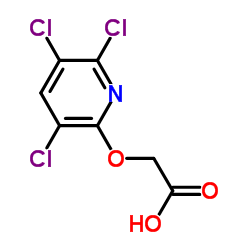

绿草定结构式

|
常用名 | 绿草定 | 英文名 | Triclopyr |
|---|---|---|---|---|
| CAS号 | 55335-06-3 | 分子量 | 256.471 | |
| 密度 | 1.7±0.1 g/cm3 | 沸点 | 359.1±37.0 °C at 760 mmHg | |
| 分子式 | C7H4Cl3NO3 | 熔点 | 148-150°C | |
| MSDS | 中文版 美版 | 闪点 | 171.0±26.5 °C | |
| 符号 |

GHS07 |
信号词 | Warning |
|
Are DNA-damaging effects induced by herbicide formulations (Roundup® and Garlon®) in fish transient and reversible upon cessation of exposure?
Aquat. Toxicol. 155 , 213-21, (2014) Owing to the seasonality of crop cultivation and subsequent periodic/seasonal application of herbicides, their input to the aquatic systems is typically intermittent. Consequently, exposure of fish to this type of contaminants can be short and followed by a p... |
|
|
Dissipation of four forest-use herbicides at high latitudes.
Environ. Sci. Pollut. Res. Int. 15(7) , 573-83, (2008) Large-scale deforestation is occurring in subarctic North America following clearing by salvage logging or insect attack. Numerous shrubs, herbs, and deciduous tree species tend to dominate areas on which stands of white spruce have grown. In the absence of e... |
|
|
Effects of herbicides on Behr's metalmark butterfly, a surrogate species for the endangered butterfly, Lange's metalmark.
Environ. Pollut. 164 , 24-7, (2012) Lange's metalmark butterfly, Apodemia mormo langei Comstock, is in danger of extinction due to loss of habitat caused by invasive exotic plants which are eliminating its food, naked stem buckwheat. Herbicides are being used to remove invasive weeds from the d... |
|
|
Determination of chlorinated acid herbicides in vegetation and soil by liquid chromatography/electrospray-tandem mass spectrometry.
J. AOAC Int. 90(5) , 1402-10, (2007) The method presented uses reversed-phase liquid chromatography with negative electrospray ionization and tandem mass spectrometry to analyze 9 chlorinated acid herbicides in soil and vegetation matrixes: clopyralid, dicamba, MCPP, MCPA, 2,4-DP, 2,4-D, triclop... |
|
|
Clinical outcome of acute intoxication due to ingestion of auxin-like herbicides.
Clin. Toxicol. (Phila.) 49(9) , 815-9, (2011) The human toxicity of synthetic auxin analogue herbicides has not been extensively studied.Clinical outcome was assessed from medical records of 17 patients who had intentionally ingested auxin pesticides with active ingredients like dicamba, triclopyr, MCPA ... |
|
|
Impact of data quality and model complexity on prediction of pesticide leaching.
J. Environ. Qual. 35(2) , 628-40, (2006) Accurate input data for leaching models are expensive and difficult to obtain which may lead to the use of "general" non-site-specific input data. This study investigated the effect of using different quality data on model outputs. Three models of varying com... |
|
|
Soil photolysis of herbicides in a moisture- and temperature-controlled environment.
J. Agric. Food Chem. 51(15) , 4331-7, (2003) The problem of maintaining the moisture content of samples throughout the course of a soil photolysis study is addressed. The photolytic degradations of asulam, triclopyr, acifluorfen, and atrazine were independently compared in air-dried soils and in moist (... |
|
|
Toxicity of neurons treated with herbicides and neuroprotection by mitochondria-targeted antioxidant SS31.
Int. J. Environ. Res. Public Health 8(1) , 203-21, (2011) The purpose of this study was to determine the neurotoxicity of two commonly used herbicides: picloram and triclopyr and the neuroprotective effects of the mitochondria-targeted antioxidant, SS31. Using mouse neuroblastoma (N2a) cells and primary neurons from... |
|
|
Toxicokinetics, recovery, and metabolism of triclopyr butotyl (ACTP) ester in goats.
J. Agric. Food Chem. 50(15) , 4202-9, (2002) Toxicokinetic behavior, recovery, and metabolism studies of ACTP ester and its effect on cytochrome P(450) content of liver microsomal pellet were carried out in black Bengal goat after a single intravenous administration of 11.88 mg kg(-1) and consecutive or... |
|
|
Developmental toxicity evaluation of triclopyr butoxyethyl ester and triclopyr triethylamine salt in the CD rat.
Reprod. Toxicol. 23(2) , 165-74, (2007) Triclopyr (3,5,6-trichloro-2-pyridyloxyacetic acid) is an herbicide used extensively in the control of woody plants and broadleaf weeds, and is often formulated as a triethylamine salt (T-TEA) or butoxyethyl ester (T-BEE). This study evaluated the development... |